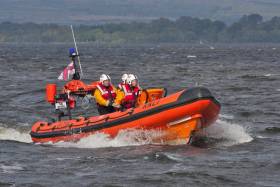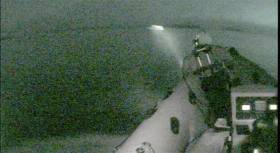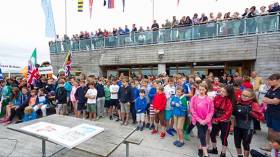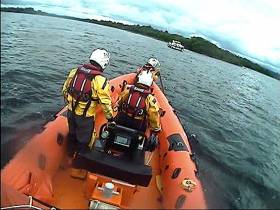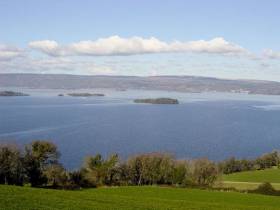Displaying items by tag: Lough Derg
Lough Derg Lifeboat Assists Fisherman On Boat Wedged In Rocky Shoal
#RNLI - Lough Derg RNLI was requested to launch by Valentia Coast Guard yesterday evening (Sunday 4 September) to assist a fisherman whose boat was wedged inside a rocky shoal.
At 5.50pm, the inshore lifeboat launched with helm Eleanor Hooker, Liam Knight and Keith Brennan on board. Winds were east-southeasterly Force 2 and visibility was good.
The lifeboat located the vessel in Youghal Bay, and the fisherman on board was found safe and wearing his lifejacket.
He was taken onto the lifeboat and an RNLI volunteer transferred across to the lakeboat before it was taken off the shoal and towed to safe harbour in Youghal Bay.
Peter Kennedy, deputy launching authority at Lough Derg RNLI, advises boat users "to bring charts with you and know the areas close to shore marked as unnavigable."
Early Morning Calls Lead To Lifeboat Launch on Lough Derg
Lough Derg RNLI Lifeboat launched at 5.20am, following reports to Gardaí of calls for help coming in off the lake.
At 05.06am this morning, Lough Derg RNLI Lifeboat was requested to launch by Valentia Coast Guard, following a report to Nenagh Gardaí of calls for help heard coming in off the lake, that woke sailors camping at Lough Derg Yacht Club.
As volunteer crew assembled, they were informed by Gardaí, who were at the Lifeboat Station, that a cruiser was seen to leave the public harbour close to the time the calls for help were heard.
The lifeboat launched at 05.18am with helm Eleanor Hooker, Ger Egan and Owen Cavanagh on board. Winds were light, southeasterly. Visibility was poor with fog and just before dawn.
The Irish Coast Guard Search and Rescue Helicopter team based at Shannon, were on standby should they be required.
The lifeboat set a route south, in the direction from which the calls were heard, and using a search light quickly located a cruiser at anchor close to the navigation channel, south of the Corrakeen Islands, outside Dromineer Bay.
The lifeboat crew roused the passengers on board and made them check that everyone was accounted for on board. The passengers said they may have been making some noise as they left the harbour earlier, and would be continuing their passage south at daybreak.
The lifeboat reported their findings to Valentia Coast Guard and, advised that the cruiser’s companion boat was moored in Dromineer Harbour, would check that they had no difficulties.
Once it was established neither vessel was missing a passenger, the lifeboat returned to station.
Brian Hanley, Deputy Launching Authority at Lough Derg RNLI Lifeboat, advises boat users to ‘respect the water, enjoy the lake, but ensure one person remains fully in command of your boat at all times’.
The lifeboat returned to Station and was ready for service again at 06.10am
Lough Derg RNLI Lifeboat Assist Nine on Cruiser With Engine Failure
At 3.30pm yesterday, Lough Derg RNLI Lifeboat was requested to launch by Valentia Coast Guard, following a report from people on shore at Mountshannon, that people were seen waving a distress signal on a cruiser outside the bay. The lifeboat launched at 3.45pm with helm Eleanor Hooker, Peter Clarke and Owen Cavanagh on board. Winds was westerly, Force 5/6 gusting 7. Visibility was good.
Nine people were on board, three adults and six children.
The lifeboat located the vessel in Mountshannon Bay at 4pm. All nine people on board were safe and unharmed and wearing their lifejackets. They had dropped anchor to prevent being pushed onto nearby rocks. An RNLI volunteer lifeboat crew was transferred to the casualty vessel where he reassured everyone, and then set up a bridle and tow. The lifeboat took the tow and went ahead of the cruiser to assist the RNLI volunteer weigh anchor, which had dug in and was holding fast.
The lifeboat towed the cruiser to Mountshannon Harbour where she was tied safely alongside at 4.30pm. The Lifeboat returned to station and was ready for service again at 5pm.
Pat Lynch, Deputy Launching Authority at Lough Derg RNLI Lifeboat advises boat users to ‘to check weather forecast before going afloat, make sure your boat is serviced and to carry a means of communication’.
Optimist Dinghy Championships Results From Day 2
#Optimist - Results from Day 2 of the 2016 Optimist National and Open Championships on Lough Derg on Tuesday 16 August:
Senior Division, Gold Fleet
1st: Harry Twomey (RCYC and Crookhaven YC) – 21 pts; 2nd: Tom Higgins (RStGYC) – 23 pts; 3rd: Blake Wilson (AUS) – 28 pts
Senior Division, Silver Fleet
1st: Eoghan Turner (NYC) – 203 pts; 2nd: Kitty Flanagan (RStGYC) – 214 pts; 3rd: Kate Horgan (RCYC) – 278 pts
Junior Division, Gold Fleet
1st: Henry Heathcote (GBR) – 17 pts; 2nd: Freddie Lonsdale (GBR) – 29 pts; 3rd: Ella Lance (GBR) – 34 pts
Junior Division, Silver Fleet
1st: Johnny Flynn (HYC) – 72 pts; 2nd: Thomas O'Neill (HYC) – 192 pts; 3rd: Eimer McMorrow-Moriarty (Tralee Bay SC) – 217 pts.
(Main Fleet Sailed: 7, Discards: 1, To count: 6, Entries – Senior Fleet: 66, Junior Fleet: 91)
Regatta Fleet
1st: Russell Bolger (RStGYC) – 7 pts; 2nd: Jessica Riordan (RStGYC) – 13 pts; 3rd: Eibhe Lubliner (RStGYC) – 15 pts
(Sailed:6, Discards: 1, To count: 5, Entries: 53)
Optimist Dinghy Championships Results From Day 1
#Optimist - Results from Day 1 of the 2016 Optimist National and Open Championships on Lough Derg, comprising Races 1, 2 and 3 on Monday 15 August:
Senior Division, Gold Fleet
1st: Harry Twomey (Royal Cork Yacht Club and Crookhaven YC) – 6 pts; 2nd: Tom Higgins (Royal St George YC) – 16 pts; 3rd: Blake Wilson (Australia) – 21 pts
Senior Division, Silver Fleet
1st: Eoghan Turner (National YC) – 95 pts; 2nd: Kitty Flanagan (RStGYC) – 111 pts; 3rd: Kate Horgan (Royal Cork YC) – 144 pts
Junior Division, Gold Fleet
1st: Henry Means (Great Britain) – 13 pts; 2nd: Hector Bennett (Great Britain) – 18 pts; 3rd: Ella Lance (Great Britain) – 21 pts
Junior Division, Silver Fleet
1st: Johnny Flynn (Howth YC) – 28 pts; 2nd: Adam Walsh (Howth YC) – 124 pts; 3rd: Thomas O'Neill (Howth YC) – 131 pts.
Regatta Fleet
1st: Russell Bolger (Royal St George YC) – 5 pts; 2nd: Rocco Wright (Howth YC) – 11 pts; 3rd: Jessica Riordan (Royal St George YC) – 11 pts
Irish Optimist Dinghy Championships Launched at Lough Derg
Lough Derg Yacht Club in County Tipperary plays host to two hundred and eight sailors from ten countries in this week's five-day, ten-race Optimist National and Open Championships.
Today's opening ceremony took place at Dromineer. Led by pipers from the Thomas McDonagh Pipe Band, sailors, their families and event volunteers marched from the square in Dromineer to the clubhouse under their national banners. They were greeted there by Niamh McCutcheon, event organiser, and David Meredith, Commodore of LDYC. Cllr. Dr. Phill Bugler, Cathaoirleach of Nenagh Municipal District formally opened the Championship.
In her opening remarks, Dr. Bugler recalled that LDYC was founded in 1835 and is one of the oldest yacht clubs in the world. It has a proud record of having produced the Irish Optimist, Laser and Topper champions and the Mirror World Champions. "The contribution of this event to the local community and economy is immense", she added, " this is a major event for our district and we thank LDYC and its volunteers for all the hard work that made it possible".
Aidan Staunton, Chairperson of IODAI, made a special presentation to Optimist sailor Tom Higgins from the Royal St. George Yacht Club in Dublin who was the first ever Irish sailor to win the British Optimist Championships in Scotland last week.
A presentation was also made to Jill Somerville who has given several years service to the Optimist Class, most recently as Chairperson, and whose contribution epitomises the best of volunteerism, without which amateur sailing in Ireland would be unable to function
Lough Derg RNLI Attend Two Separate Cruisers Aground
There have been two back to back callouts for Lough Derg RNLI Lifeboat to assist a family of seven on a 40ft–cruiser aground at the Goat Road, and to assist a family of five on board at 35ft–cruiser aground at Ryan’s Point, Lough Derg
Lough Derg RNLI Lifeboat launched at 2.26pm this afternoon, Saturday July 30, following a request from Valentia Coast Guard to assist a family of seven, three adults and four children, on board a 40ft cruiser aground at the Goat's Road (a nesting elevation for migrating birds) at the eastern shore of Lough Derg.
Winds were northwesterly, Force 3, visibility was very good.
At 2.38pm, the lifeboat, with helm Eleanor Hooker, Ger Egan and Lian Knight on board, located the vessel inside the Goat Road. The seven people on board were unharmed and all wearing their lifejackets.
A RNLI volunteer lifeboat crew was transferred to the casualty vessel where he reassured everyone and checked for any damage to the hull and any ingress of water. Satisfied that the boat was not holed, he set up a tow and the lifeboat took the vessel off the rocks and out into safe water. The drives and propellers were checked to ensure they had suffered no damage, and, after pointing out their safe route on their navigations charts, the cruiser made way to Dromineer under its own power.
At 3.20pm and on their return journey to Dromineer, Valentia Coast Guard requested Lough Derg RNLI lifeboat to go the assistance of a family of five, two adults and three children, whose 35ft cruiser had run aground on a rocky shoal by Ryan’s Point, midway down the eastern shore of Lough Derg. The lifeboat located the vessel at 3.27pm.
A RNLI volunteer lifeboat crew was transferred to the casualty vessel where he reassured everyone and distributed survivor lifejackets to those who had none.
He checked for any damage to the hull and once he was happy that the boat was not holed, set up a tow. The lifeboat took the vessel off the rocks and out into safe water. The drives and propellers were checked to ensure they were in working order. The cruiser continued on its onward journey.
The Lifeboat returned to station and was ready for service again at 5pm.
Pat Garland, Deputy Launching Authority at Lough Derg RNLI Lifeboat advises boat users to ‘to carry enough lifejackets for everyone on board and to ensure they wear them, and to study their charts and stay within the navigation marks on the lake’.
Lough Derg Floating Moorings at Mountshannon Harbour Reopen
Waterways Ireland say that floating moorings in Mountshannon Harbour on Lough Derg which had been closed to the public due to damage as a result of winter floods have now been reopened.
#RNLI - Lough Derg RNLI's lifeboat launched this morning (Friday 1 July) to assist four people on board a 40ft cruiser whose anchor came loose and dragged beneath their boat in severe weather.
At 11.20am Valentia Coast Guard requested the lifeboat to attend to the cruiser located by Hare Island.
The lifeboat launched at 11.42am with helm Peter Clarke, Lorna Walsh and Barry Morkan on board. Winds were south-westerly Force 5, gusting 6/7, with good visibility.
The lifeboat was alongside the cruiser at 11.52am. Everyone on board was safe and unharmed and wearing their lifejackets.
An RNLI crew member reassured everyone on board the cruiser. Given the severe weather conditions and the exposed location, it was decided to let the anchor go when it could not be recovered back on board after numerous attempts.
The cruiser for any other potential problems, and everything was found to be in working order, so it continued its journey to the public harbour at Dromineer where it took shelter.
The lifeboat returned to station and was ready for service again at 1.14pm.
Lifeboat operations manager Liam Maloney advises boat users to "check the weather before setting out from harbour and ensure all items are stowed correctly".
Lough Derg Fish Stock Survey Under Way
#Angling - Inland Fisheries Ireland (IFI) is currently carrying out a fish stock survey on Lough Derg to assess the current status of the fish populations in the lake.
The survey began on Monday 13 June and continues till Friday 1 July. It involves the netting of over 200 sites throughout Lough Derg and Parteen reservoir.
Four different types of survey nets are being used. Many of these survey nets are being set on the lake bed but a small proportion are being set as floating survey nets on the surface. A hydroacoustic survey of the deeper parts of the lake is also being undertaken.
The fisheries research survey will be conducted by IFI under the supervision of Inland fisheries research staff and will include a total of five boat crews with one of these working at night.
The survey will provide a range of information on the fish stocks in the lake, such as size distributions of fish captured, age and growth information for all species, diet of selected species, and catch per unit effort (CPUEs) for each fish species.
It will also provide information on the status of pollan, a rare and endangered fish species. In addition, samples for genetic analyses of brown trout and pike and other species will be taken.
The survey crews will be very visible on Lough Derg over the next few weeks and all sets of nets will be marked with distinctive buoys labelled ‘IFI Survey’.
Any anglers or other lake users are asked to be vigilant if out and about on the lake over the next few weeks and to avoid snagging in the nets.
For more information see the Lough Derg survey FAQ on the IFI website HERE.




























